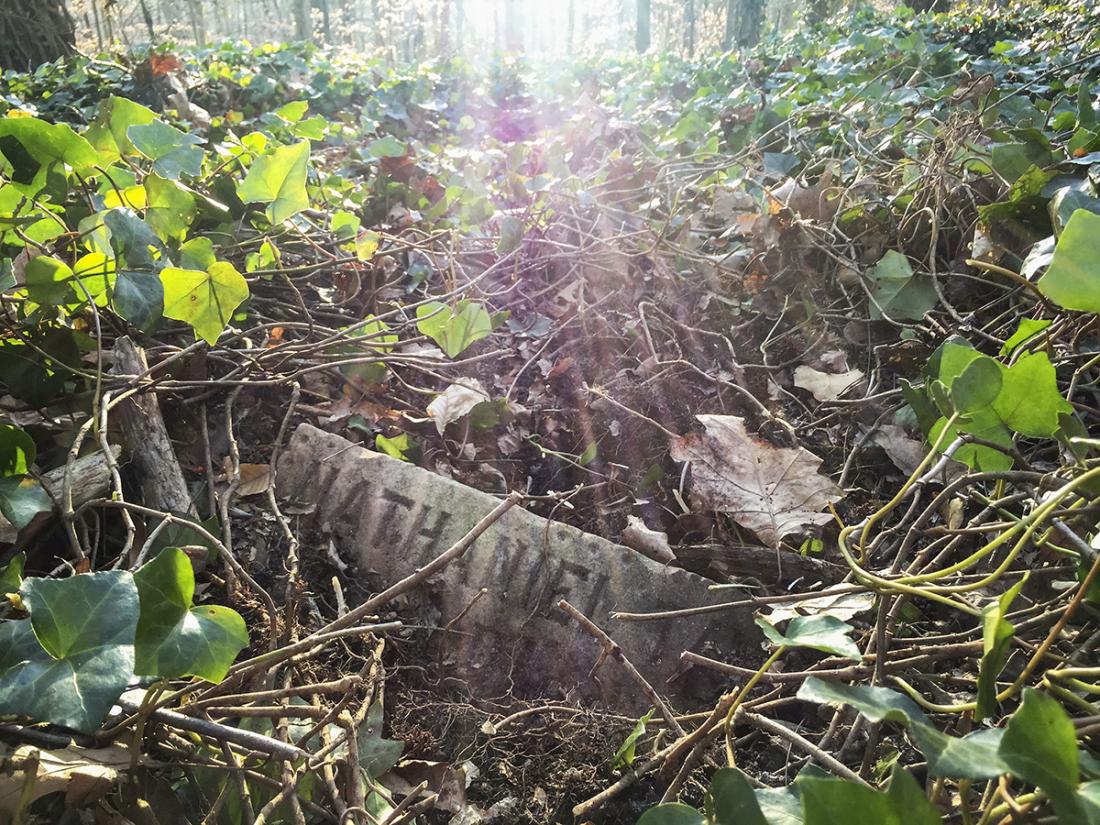By documenting the neglect and restoration of East End Cemetery, 1708 Gallery’s The Afterlife Of Jim Crow examines the way racism continues to affect African-American communities — even after death.
On the border of Henrico County, minutes from Interstate 64, sits Richmond’s formerly abandoned East End Cemetery. Neglected for decades, tangles of English ivy now coat pathways and graves alike. The surrounding forest has reclaimed the land, with oak and walnut trees growing straight up from burial sites.
For almost six years, volunteers and community members have been working to reclaim East End Cemetery — and its history.
Among East End’s clean-up volunteers are Brian Palmer and Erin Holloway Palmer, members of the Friends of East End Cemetery. The Palmers have brought their background in journalism, photography, and research together to create a contemporary art exhibit focused on the history of East End. The Afterlife of Jim Crow is currently on display at 1708 Gallery, in Richmond’s Arts District.
“I’ve tried to express both sides of what we’ve found at East End Cemetery,” Palmer said. “There’s the tragedy of neglect, but the tragedy does not define the place. This is a sacred site and this is an outdoor archive of the African American, the Richmond, the American experience. All of that is here, it may be buried under vines and, in some places, illegally dumped trash, but there is beauty, there is love expressed in these headstones, on the inscriptions — and there is a tremendous amount to learn.”
African Americans founded East End Cemetery in 1897, when they were often forbidden from burying their dead in white cemeteries. An estimated 17,500 people are buried at East End, some born into slavery, others into reconstruction and the era of Jim Crow laws. Among the graves are people of various stature, some prominent: doctors, bankers and business owners. Others are less distinguished farmers, cooks and tailors.
There are veterans like Clarence Hubbard, who was one of the first African Americans to join the Marine Corps, and free people of color like Josephine Johnson, who was marked among the “Free Inhabitants” of Richmond on the 1850 census. Johnson has the earliest death date in the cemetery: 1882, 15 years before the cemetery was established.

The Palmers first visited the cemetery in 2014, while working on a documentary. That documentary, Make The Ground Talk, focused on a black community in the Williamsburg area that was evicted through eminent domain; as part of the documentary, the Palmers obtained permission from the government to visit the cemetery where Brian Palmer’s great-grandparents are buried. This project ultimately led them to another African-American cemetery that had also suffered decades of neglect: East End Cemetery.
During a lull in the filming process, Holloway Palmer found herself drawn into the cleanup efforts.
“Since [Erin] wasn’t shooting or anything, she dropped down on her knees and started volunteering with the Boy Scouts who were working there,” Palmer said. That was the beginning of their work with the cemetery.
“She just got it,” Palmer said. “And she encouraged me to put my camera down the next time we visited. And I kind of got it — the idea of doing with our hands what we were doing with our heads … we could help reclaim African American history with our hands, and that was a pretty darn powerful thing to be able to do.”
In the gallery space, elevated photos scatter the hardwood floor like grave markers. Photos show broken and abandoned grave sites — like one of a headstone, barely visible in a sea of orange lilies.

“It mimics the feeling of stepping through the stones at the cemetery,” Holloway Palmer said.
Park Myers, the 1708 Gallery curator, said the walk through the photos was designed to demonstrate the Palmers’ experience “when they’re unearthing and uncovering and reclaiming these histories.”
In the background of the gallery, the sounds of the cemetery play lightly — volunteers stepping through piles of dried leaves, vines being pulled and torn away from headstones.
Myers finds strength in the duality of the images and sounds.
“You’re able to focus on the images and somehow the sound kind of falls to the background,” Myers said. “Then when you’re not (focused on the images), the sound becomes very present.”
In the main gallery space, the bare walls pull your eyes to the back of the room, where a projector displays an important part of the restoration project — a new interactive website.

Holloway Palmer describes the new website as “a community asset.”
“It was … important to make sure it was collaborative,” said Jolene Smith, the website’s developer.
The website, which is split into three parts, allows for community contributions. The first part, “People,” identifies the known gravesites from East End Cemetery. So far, 245 burials have been identified on the website.
“Whenever we find a headstone, we try to find out whatever we can about a person,” Holloway Palmer said. “What we’re able to find really varies.”
Profiles for the deceased are assembled with information from Ancestry.com and other sites that track historical documents. Old newspapers are also of value, specifically the Richmond Planet, an African American newspaper that ran from 1883 until 1996.
Despite the resources, the Palmers and Smith still need community contributions to complete and contextualize the stories of these individuals. People who know of family members buried in East End Cemetery are encouraged to contribute photos, information and stories. They can fact-check information the Palmers have come across, and contribute missing elements.

The other sections of the website, “Places” and “Context,” are dedicated to the history of the African American community in Central Virginia.
“You’re getting a sense of not just the individuals, but also the institutions they created; businesses, schools — and also places they were excluded as African Americans,” said Holloway Palmer.
A map takes the website visitor on a tour of important locations in African American History; places like the First African-American Baptist Church, which opened in 1841, and the tobacco factories of downtown Richmond, where the website says many of those buried at East End worked.
With inspiration from the website, the cleanups, and the exhibit, Brian Palmer wants communities to reconnect with their forgotten histories.
“There are hundreds of these places around the country — historic black cemeteries, native American cemeteries, paupers’ cemeteries,” Palmer said. “Stories are in these places that help us understand ourselves. We just have to look.
The Afterlife Of Jim Crow is on display at 1708 Gallery, located at 319 W. Broad St, until Saturday, March 23. For more information, go to 1708 Gallery’s website.
Photos by Brian Palmer and Erin Holloway Palmer, via 1708 Gallery



